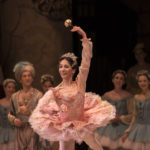Louisville Ballet’s 65th Anniversary Season has given the company and Louisville audiences the full spectrum that this art form has to offer. The Ballet opened its season with a program that emphasized the company’s broad range—from Balanchine’s 1947 Theme and Variations with tutus and pink tights, to Twyla Tharp’s 1986 In the Upper Room with sneakers and fog, to Robert Curran’s world premier How They Fade with socks and projections. Swan Lake took a nineteenth century classical ballet and added a modern twist with laser lights, new costumes, and a new perspective on the story. The tradition of Nutcracker stood strong and true, Choreographer’s Showcase presented new, inventive works, and Human Abstract pushed the limit of where art can go. This weekend Louisville Ballet concludes its celebration of 65 years making moving art with the timeless The Sleeping Beauty. Just as Louisville Ballet is rich in history, this ballet offers a wealth of tradition and wisdom.
The Imperial Ballet first performed The Sleeping Beauty for the Tzar at the Mariinsky in 1890. The ballet itself was almost four hours, and the intermissions during that time would last as long as the Royal Family desired. Often times dinner would even be served during intermissions. The Sleeping Beauty was first performed in London in the mid-1920s by Diaghilev’s Ballets Russes. Nikolai Sergueev, of the Mariinsky Theatre, staged the ballet from several volumes of notations. The décor for the production was elaborate and expensive, unfortunately bankrupting the company. The ballet’s premiere in England was not a success. The public was accustomed to viewing three one-act ballets, as opposed to the extensive four act The Sleeping Beauty. In addition to these damaging factors, everything went wrong on opening night. Scenery and costume malfunctions abounded. Dancing and lighting errors also plagued the performance. In 1930 The Sleeping Beauty was given another opportunity in England. This time the costumes and scenery were simplified, giving an overall feeling of austerity. Margot Fonteyn, performing Aurora, was very disappointed. Though this rendition of the great ballet was more of a success, it still was not a triumph. The ballet was better received in 1947 when it was performed at the Royal Opera House, Covent Garden after World War II, giving viewers an escape from the horrors of the era. Providing an outlet of fantasy and beauty in which to be swept away. Reminding humanity that goodness still exists, and peace can be victorious—despite the vast darkness threatening to devour. Two years later, The Sleeping Beauty was performed for the first time in the United States at the old Metropolitan Opera House. The ballet had the most incredible success. Many of the patrons had never seen a full length ballet before, establishing The Sleeping Beauty as the keystone—the big production everyone loved, and continues to love today.
An important element in The Sleeping Beauty is the gap between the aristocracy and lower classes. Helen Starr explains that without this component, the ballet becomes flat. She professes the challenge this offers to American dancers having grown up in such a young country with no historical background of walking about with gentlemen adorned in waist coats, heels, wigs, and hats with feathers. In Europe it is easier for dancers to assimilate to a very different style of being a human being because they are surrounded by these historical features. For example, they do not have to imagine what a peasant hovel is, because peasant hovels are still there. This makes The Sleeping Beauty more difficult, and perhaps even more important, for dancers from this country. Starr muses that, while other classical ballets are often moved into more current or contemporary settings, The Sleeping Beauty always remains a period ballet. She describes it as walking into a museum where everything comes to life. Smiling, she declares her belief that “modern children can still be beguiled by fairy stories.”
Magic. Fairies. Monsters. Curses. Princes. Princesses. Kings. Queens. True love’s kiss. Happily Ever After. The Sleeping Beauty is a fairy tale. The ballet will transport audiences into a new time and place. A new world—rooted in old traditions. This production is a fitting transition into Louisville Ballet’s next season—the Season of Enchantment. The Ballet will carry audiences into the heart of stories—new and old. The company will explore new boundaries with a brand new, vibrant Firebird; return to the annual magical Land of the Sweets; delve into the heart wrenchingly beautiful Giselle; and more. This weekend Louisville Ballet welcomes in this magical new season, while bidding farewell to the current season and paying tribute to the company’s incredible history. Honoring those many dedicated souls who made this celebration possible. Memorializing this incredible art form that brings so much beauty and understanding to our world. Come celebrate 65 years of bringing extraordinary art to the city of Louisville. Come step back into history. Come commemorate the heritage of this company and this art form. Come be enchanted.
Jones, A. (2017, March, 7). Personal Interview.
Starr, H. (2017, March 14). Personal Interview.

